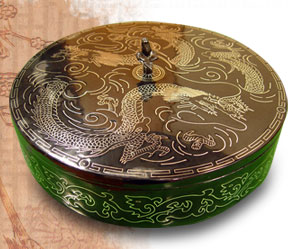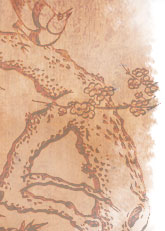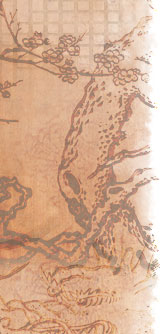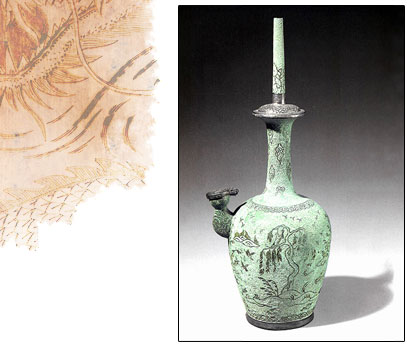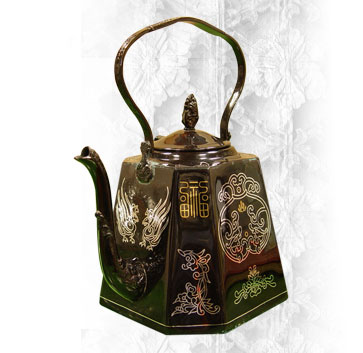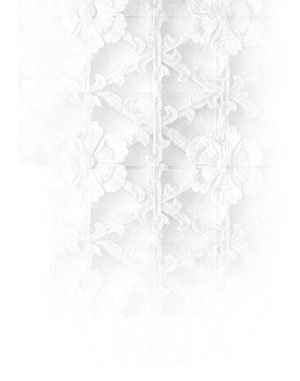 The tip of a chisel running along the surface of a metal object creates an orchid opening its petals to The tip of a chisel running along the surface of a metal object creates an orchid opening its petals to
 gently quiver in the air, two rivaling tigers roaring angrily at each other, or a dragon with a magic
gently quiver in the air, two rivaling tigers roaring angrily at each other, or a dragon with a magic
 pearl in its mouth soaring up into the sky. The delightful sounds of a tiny hammer gently
pearl in its mouth soaring up into the sky. The delightful sounds of a tiny hammer gently
 striking the chisel and the delicate movements of the chisel tip lead by an artisan’s skillful
striking the chisel and the delicate movements of the chisel tip lead by an artisan’s skillful
 hands composes a perfect harmony to produce a wonderful natural landscape. Exquisite
hands composes a perfect harmony to produce a wonderful natural landscape. Exquisite
 patterns and forms made only by a small chisel and a hammer proclaim their exuberance
patterns and forms made only by a small chisel and a hammer proclaim their exuberance
 to the world.
to the world.
 The glorious history of metal art work in Korea dates back to the Bronze Age. The fine The glorious history of metal art work in Korea dates back to the Bronze Age. The fine
 geometrical patterns on a Danyusemun-gyeong (‘Bronze Mirror with Fine Linear Design and
geometrical patterns on a Danyusemun-gyeong (‘Bronze Mirror with Fine Linear Design and
 Knobs on the Back’), one of the major relics surviving from that age, clearly demonstrates the
Knobs on the Back’), one of the major relics surviving from that age, clearly demonstrates the
 highly advanced techniques that the ancient Korean metalworkers developed on the peninsula.
highly advanced techniques that the ancient Korean metalworkers developed on the peninsula.
 The art began to develop further once more complex metal work methods arrived from China during the
The art began to develop further once more complex metal work methods arrived from China during the
Iron Age. Apart from Chinese influences, Koreans never stopped expanding their own skills, which resulted in the
glorious achievements we see today from the treasures of the Silla Dynasty
(57 B.C.-935 A.D.), including gold
crowns and other ornaments of precious metals used by the Silla royal family. These incredible pieces are highly
regarded in terms of both artistic techniques and aesthetic beauty.
The introduction of Buddhism in the 4th century, and with it various Buddhist paraphernalia including sarira
cases from China and India, propelled forward the development of Korean metal works. The most opulent metal work
items from the Three Kingdoms Period (57 B.C.-668 A.D., the period when the three ancient Korean kingdoms,
Koguryo, Baekje and Silla, rivaled each other) includes crowns, crown ornaments, earrings, bracelets, rings, belt
ornaments, necklaces and swords, as well as Buddhist objects such as sarira cases, miniature pagodas and
incense burners. These pieces exemplify the diversity of techniques and styles of Korean metal art work in its
early history.

 Gold Crown of Silla Gold Crown of Silla
 Silla Dynasty, 5-6th Century Silla Dynasty, 5-6th Century
 27.5cm in height and 17cm in diameter 27.5cm in height and 17cm in diameter
 This gold crown from the Silla Dynasty has three uprights in a three-tier This gold crown from the Silla Dynasty has three uprights in a three-tier
 山 shape at the front and both sides of the base ring, two deer-horn 山 shape at the front and both sides of the base ring, two deer-horn
 ornaments placed vertically at both sides of the back, and three pairs ornaments placed vertically at both sides of the back, and three pairs
 of gold pendants in different lengths dangling down in a symmetrical of gold pendants in different lengths dangling down in a symmetrical
 design. With no similar pattern found anywhere else in the world, this design. With no similar pattern found anywhere else in the world, this
 crown exhibits the greatest artistic triumph that one can attain with gold. crown exhibits the greatest artistic triumph that one can attain with gold.
 There are also a number of tiny round golden leaves attached to upright There are also a number of tiny round golden leaves attached to upright
 ornaments as well as the base ring that reflect brilliant golden light in ornaments as well as the base ring that reflect brilliant golden light in
 different tones. The radiance of golden light creates a wonderful harmony different tones. The radiance of golden light creates a wonderful harmony
 of colors with bluish-green jade droplets attached in intervals. These of colors with bluish-green jade droplets attached in intervals. These
 numerous tiny ornaments fashioned a resplendent dance of colors numerous tiny ornaments fashioned a resplendent dance of colors
 whenever its wearer made the slightest movement. whenever its wearer made the slightest movement.

The metal work of the Goryeo Dynasty (918-1392) also developed through
the advent of Buddhist paraphernalia. The main techniques of Goryeo metal art work
include wire inlaying, incising bold and fine lines, carving outspots, plastering with
borax, and scraping away the background leaving designs in relief. Of them all,
the wire-inlaying technique, one that is similar with the inlaying technique of
Goryeo celadon ware by which wires of precious metals such as gold and
silver are inlaid into incised lines on a metal work’s surface to create a
plethora of images, was particularly popular with Goryeo artisans. Remaining
relics such as kundika bottles and incense burners inlaid with designs of willow
trees and animals clearly show the advanced techniques of Goryeo metal work.
The art of Korean metal work further evolved and specialized during the Joseon
Period (1392-1910) during which, according to the book Daejeon Hoetong
(‘Comprehensive Assembly Code’), about 30% of the entire
government-supported artisans in the capital were metalworkers.

 Bronze Ewer Inlaid with Bronze Ewer Inlaid with
 Silver Willow and Birds Design Silver Willow and Birds Design
 Goryeo Dynasty, 12th Century Goryeo Dynasty, 12th Century
 37.5cm in height and 12.9cm in diameter at its widest point 37.5cm in height and 12.9cm in diameter at its widest point
 This ewer, or kundika bottle that was used for offering water to Buddha This ewer, or kundika bottle that was used for offering water to Buddha
 during prayer services, exhibits a well-proportioned shape with elegant during prayer services, exhibits a well-proportioned shape with elegant
 curved lines. It is also one of the greatest remaining Goryeo relics curved lines. It is also one of the greatest remaining Goryeo relics
 displaying the fine workmanship of the dynasty’s silver-inlaying technique. displaying the fine workmanship of the dynasty’s silver-inlaying technique.
 This practice of inlaying precious metal such as silver into the engraved This practice of inlaying precious metal such as silver into the engraved
 lines on a metal surface is often compared with the unique inlaying lines on a metal surface is often compared with the unique inlaying
 technique of Goryeo celadon pottery. In this ewer, the neck is decorated technique of Goryeo celadon pottery. In this ewer, the neck is decorated
 with a motif of clouds and tree leaves, the silver spout cover with an with a motif of clouds and tree leaves, the silver spout cover with an
 arabesque design carved using an openwork method, and the main arabesque design carved using an openwork method, and the main
 body with a scene of a lakeside featuring a willow tree and ducks, body with a scene of a lakeside featuring a willow tree and ducks,
 composing a wonderful landscape painting. The inlaid silver lines composing a wonderful landscape painting. The inlaid silver lines
 delightfully contrast the jade blue background created by the rust of the delightfully contrast the jade blue background created by the rust of the
 bronze body. The peaceful scene of a fisherman beside a lake that is bronze body. The peaceful scene of a fisherman beside a lake that is
 thick with reeds and birds under and around a willow tree exemplifies thick with reeds and birds under and around a willow tree exemplifies
 serenity for the viewer.
serenity for the viewer.
View the master's works |













